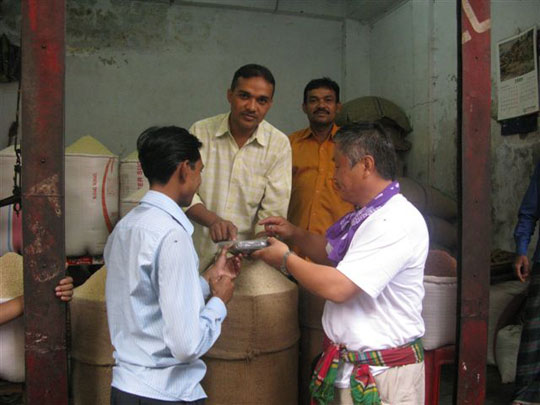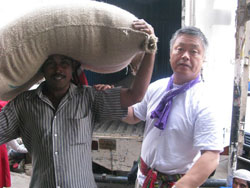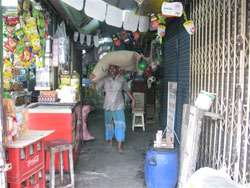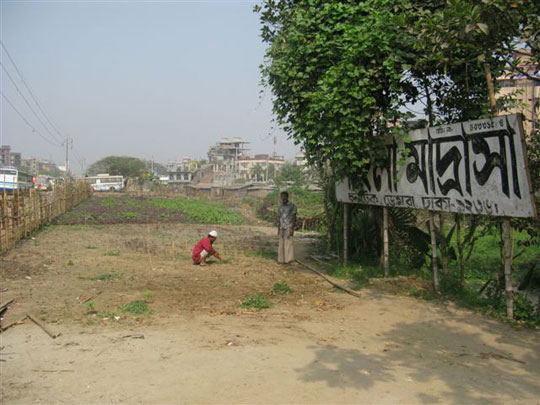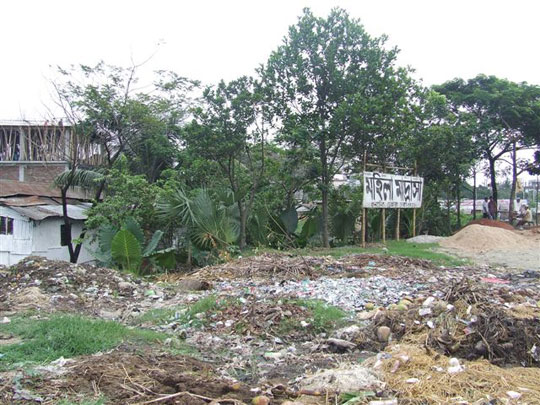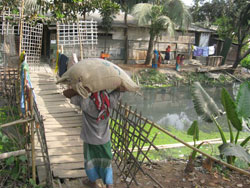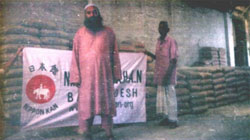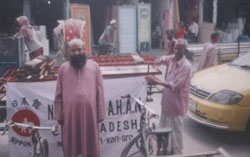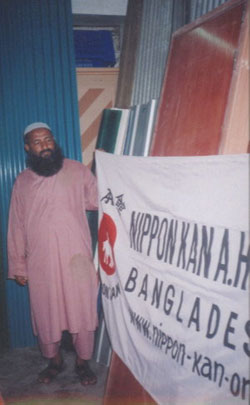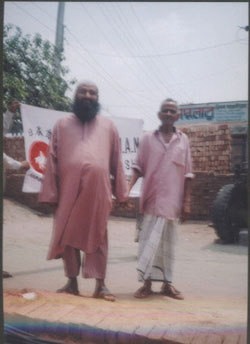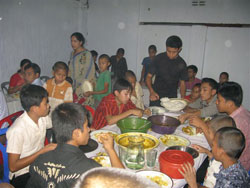March 5th-March 8th, 2009
After leaving Nepal, Homma Kancho took a quick trip to Bangladesh to check on ongoing AHAN projects there. Currently AHAN supports two orphanages in Dhaka with one ton of rice per month, computers and other building, medical and school supplies. On this trip, Homma Kancho was also interested in researching a facility he had heard of west of the capital city of Dhaka.
The first morning, Homma Kancho and I (Maji) arranged for the March delivery of ½ ton of rice to the Dharmarajika Buddhist Temple and Orphanage for boys. After the rice had been delivered and stored, we joined all of the children for lunch. Serving close to 500 boys at one sitting is quite the undertaking, especially considering the available kitchen facilities. All of the boys were happy to be fed however and seemed to enjoy the new guest in their midst.
In the afternoon we went to the Madrasa Muslim Mosque Orphanage for girls with the second ½ ton of rice delivery for the day. Homma Kancho checked carefully on the progress of the ongoing constructor of a new school house. The last of the four floors was being erected and they were in need of cement, bricks, window frame, tile and other construction materials. Homma Kancho made arrangements to donate the needed supplies and delivery arrangements were made for the next day.
The teachers at the orphanage had been busy on a project that made Homma Kancho very surprised and happy! When we first came to the orphanage a year ago, you had to cross over a rickety hand-made bridge that stretched over a swamp area filled with trash. To Homma Kancho’s surprise, part of the swamp area had been filled in and vegetable gardens had been planted on both sides of the approaching path. This garden, beginning to grow before our eyes were planted with seeds that Homma Kancho donated last year.
With a few hours left in the day, Homma Kancho wanted to go to the rice merchant area of the local markets to compare shop owner prices. He carefully checked the prices and quality of the rice from each merchant; finally deciding to stay with the same merchant we had purchased rice from last year. Last year’s merchant still had the best prices, and his reputation of reliability remained untarnished. For all of last year, his rice was delivered in full and on time.
NEGOTIATING
- Merchant employee lifting a 100 kilo sack of rice easily to the top of his head!
- Carrying ten, 100 kilo sacks of rice for one hundred meters to the truck!
MADRASA MUSLIM GIRLS ORPHANAGE
- New gardens bloom with seeds from Homma Kancho.
- Three years ago this garden was a trash filled land fill.
- Delivering the rice.
- In the kitchen
- Finish school building almost done. Meeting to discuss needed supplies
- Construction site for school building
Everybody; ready…set…GO!
- Cement
- Metal
- Plastic
- Bricks
Delivery of school building materials. Photos sent by Maji, AHAN Bangladesh Coordinator
DHARMARAJIKA ORPHANAGE
- Merchant employee still going strong; delivering rice at the boy’s orphanage.
- Rice storage room at the boy’s orphanage.
- The boys rush in for lunch!
- Big appetites!
- Lined up waiting for lunch.
- Curry is the main dish most days.
Our work being completed in Dhaka, we climbed on a bus for a five hour bus ride to the city of Chiitagong. To say this ride was restful would not be quite accurate. After reaching Chiitagong, our next destination was another 130 kilometers south to a remote village near the Myanmar/Bangladesh border that housed a facility we were interested in seeing. While Bangladesh is currently primarily Muslim, Myanmar is a predominately Buddhist country with small Islamic communities as minorities. These Islamic communities are at times persecuted and under the current Myanmar government rule, are not eligible for official citizenship. Sometimes harassed and mainly country-less, groups of these Islamic people of Myanmar migrate frequently to Bangladesh; living sporadically on both sides of the border. Neither country welcomes these people for reasons of their own, making survival tenuous and living extremely difficult for this community. The facility we had heard about offered meager assistance to orphaned and handicapped girls from these roving Islamic communities. Known for violent kidnappings, thefts and even murders of foreign nationals, special permission from the Bangladesh government is needed to enter nearby areas.
No taxi driver in Chiitagong wanted to take us to this dangerous area. After asking many drivers we finally found a driver willing to take us to there and negotiated for the ride there…and back, up front!
- Homma Kancho keeps a low profile by hiding his face in scarf.
- The long ride down a bumpy road.
Homma Kancho wore a headscarf that covered his face as we set out on the last leg of the journey to our destination deep into Bangladesh countryside. Having had bad experiences before in other countries, Homma Kancho feared that if his visit was announced and the time schedule set precisely that we might be met with a staged presentation of facility activities. The original plans for this visit had been cancelled, and we set out on our own and unannounced. The purpose of this unannounced visit was to fairly assess the facility for possible future AHAN support. Homma Kancho was sorry for canceling the plans made by facility organizers, but this was done for fairness and for safety. It could be very dangerous to follow a prearranged set schedule in such a volatile region.
When we arrived, we found that our suspicions and precautions had been well founded. This facility is associated with a Japanese NGO, but we were not able to confirm there was any activity at this location. For security reasons I cannot go into detail, but as it turned out, the facility we visited seemed more like a façade for soliciting donations than a true humanitarian facility. We returned quickly to Chiitagong, leaving that dangerous area behind us.
I caution people to be careful about supporting facilities that operate in areas where foreigners are not even allowed to go. Even with the best of humanitarian intentions, it is important to confirm and be able to monitor donation allocations personally before supporting any humanitarian organization. Beware especially of internet appeals for donations. Many cyberspace solicitations are extremely difficult to authenticate and monitor. If you are not able to visit personally organizations that you would like to support, I suggest you select organizations with a long track record such as the Red Cross for example.
- A rusted sign was the only evidence of activity.
- Scattered refugees living in tents along the road.
My country of Bangladesh receives aid from many countries and my people are very thankful. There are many good organizations to support here in Bangladesh, but there are also bad ones. As AHAN Bangladesh Coordinator I agree with AHAN General Headquarter policy in its thorough, hands-on investigative approach toward project support.
LINK HERE to What Can We Learn From these Pictures?
Homma Kancho’s visit this time to Bangladesh was very short and extremely busy. We were able to accomplish many things in such a very short time. Thank you very much as always.
Written by
Maji Sarkar
AHAN Bangladesh Coordinator



